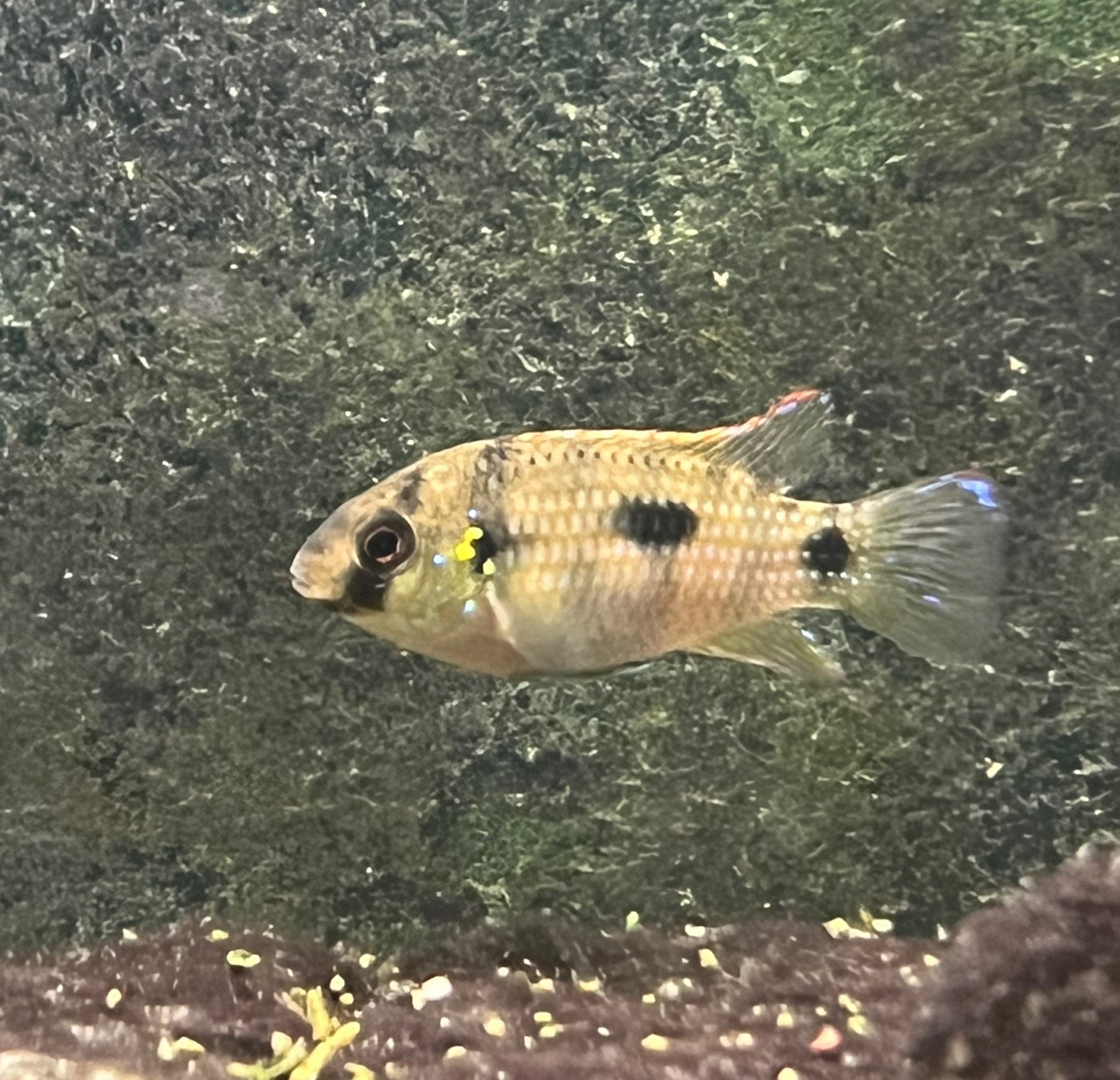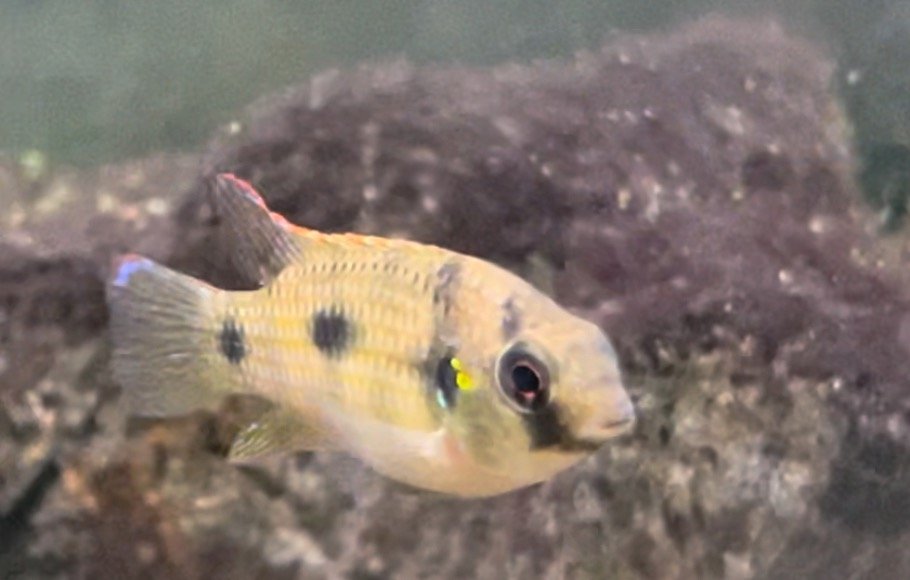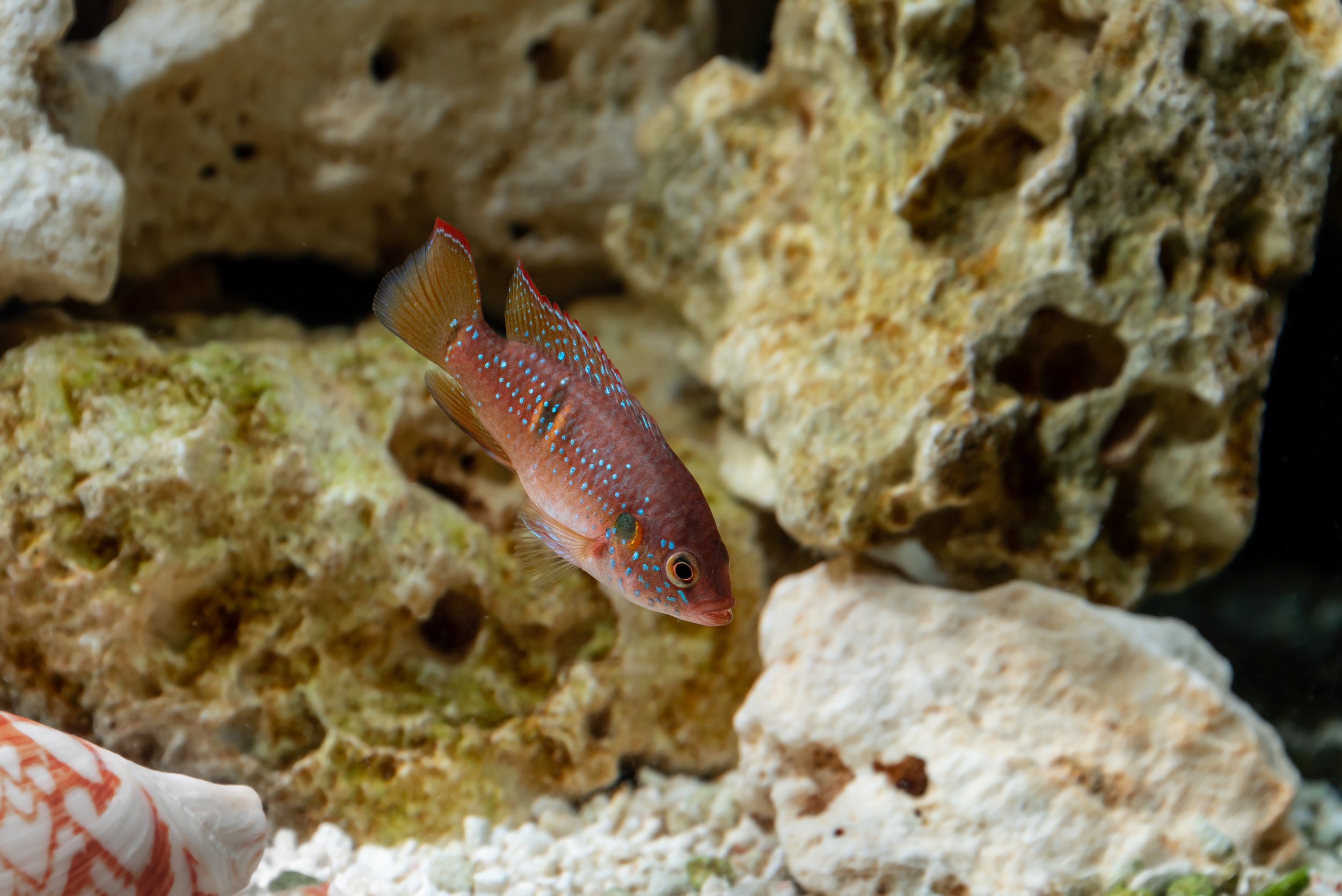 Image 1 of 2
Image 1 of 2

 Image 2 of 2
Image 2 of 2



African Butterfly Cichlid-S
The African Butterfly Cichlid, also known as Anomalochromis thomasi, is a charming freshwater fish native to the streams and creeks of West Africa, particularly in Nigeria and Cameroon. Renowned for its striking appearance and peaceful demeanor, the African Butterfly Cichlid is a popular choice among aquarists looking to add color and tranquility to their aquarium setups.
Physically, the African Butterfly Cichlid features a slender and elongated body with vibrant coloration. Its body is typically adorned with beautiful orange to reddish-brown hues, while its fins may display accents of blue or turquoise. Additionally, the species showcases intricate patterning and markings that enhance its overall aesthetic appeal. Mature specimens generally reach lengths of around 2.5 to 3 inches (6 to 7.5 centimeters).
In aquariums, African Butterfly Cichlids are known for their peaceful nature, making them excellent community fish. They thrive in well-established tanks with plenty of hiding spots provided by rocks, driftwood, and plants. While they can be kept in pairs or small groups, it's essential to avoid housing them with aggressive tank mates to prevent conflicts. Compatible tank mates include other peaceful fish species that share similar water parameter requirements.
Water parameters for African Butterfly Cichlids should mimic their natural habitat conditions to ensure their health and well-being. They prefer warm water temperatures ranging from 75 to 82°F (24 to 28°C) and slightly acidic to neutral pH levels between 6.5 to 7.5. Providing a well-filtered aquarium with regular water changes helps maintain optimal water quality and promotes the overall health of these fish.
When it comes to diet, African Butterfly Cichlids are omnivorous and will readily accept a varied diet. A combination of high-quality flake or pellet food, supplemented with live or frozen foods such as bloodworms, brine shrimp, and daphnia, ensures their nutritional needs are met. Additionally, offering vegetable matter in the form of blanched spinach or algae-based foods provides essential fiber and nutrients.
Breeding African Butterfly Cichlids in captivity is possible with the right conditions and setup. A separate breeding tank with fine substrate and flat rocks or spawning sites encourages spawning behavior. Once eggs are laid, the parents will typically guard and care for the fry until they are free-swimming. The fry can then be fed finely powdered commercial fry foods or infusoria until they are large enough to accept standard fish fare.
Overall, the African Butterfly Cichlid is a delightful and peaceful addition to freshwater aquariums, prized for its captivating appearance and gentle demeanor. Whether kept in a species-specific setup or a community tank, these charismatic fish bring beauty, tranquility, and enjoyment to any aquatic environment, making them a cherished choice among aquarists of all experience levels.
The African Butterfly Cichlid, also known as Anomalochromis thomasi, is a charming freshwater fish native to the streams and creeks of West Africa, particularly in Nigeria and Cameroon. Renowned for its striking appearance and peaceful demeanor, the African Butterfly Cichlid is a popular choice among aquarists looking to add color and tranquility to their aquarium setups.
Physically, the African Butterfly Cichlid features a slender and elongated body with vibrant coloration. Its body is typically adorned with beautiful orange to reddish-brown hues, while its fins may display accents of blue or turquoise. Additionally, the species showcases intricate patterning and markings that enhance its overall aesthetic appeal. Mature specimens generally reach lengths of around 2.5 to 3 inches (6 to 7.5 centimeters).
In aquariums, African Butterfly Cichlids are known for their peaceful nature, making them excellent community fish. They thrive in well-established tanks with plenty of hiding spots provided by rocks, driftwood, and plants. While they can be kept in pairs or small groups, it's essential to avoid housing them with aggressive tank mates to prevent conflicts. Compatible tank mates include other peaceful fish species that share similar water parameter requirements.
Water parameters for African Butterfly Cichlids should mimic their natural habitat conditions to ensure their health and well-being. They prefer warm water temperatures ranging from 75 to 82°F (24 to 28°C) and slightly acidic to neutral pH levels between 6.5 to 7.5. Providing a well-filtered aquarium with regular water changes helps maintain optimal water quality and promotes the overall health of these fish.
When it comes to diet, African Butterfly Cichlids are omnivorous and will readily accept a varied diet. A combination of high-quality flake or pellet food, supplemented with live or frozen foods such as bloodworms, brine shrimp, and daphnia, ensures their nutritional needs are met. Additionally, offering vegetable matter in the form of blanched spinach or algae-based foods provides essential fiber and nutrients.
Breeding African Butterfly Cichlids in captivity is possible with the right conditions and setup. A separate breeding tank with fine substrate and flat rocks or spawning sites encourages spawning behavior. Once eggs are laid, the parents will typically guard and care for the fry until they are free-swimming. The fry can then be fed finely powdered commercial fry foods or infusoria until they are large enough to accept standard fish fare.
Overall, the African Butterfly Cichlid is a delightful and peaceful addition to freshwater aquariums, prized for its captivating appearance and gentle demeanor. Whether kept in a species-specific setup or a community tank, these charismatic fish bring beauty, tranquility, and enjoyment to any aquatic environment, making them a cherished choice among aquarists of all experience levels.
The African Butterfly Cichlid, also known as Anomalochromis thomasi, is a charming freshwater fish native to the streams and creeks of West Africa, particularly in Nigeria and Cameroon. Renowned for its striking appearance and peaceful demeanor, the African Butterfly Cichlid is a popular choice among aquarists looking to add color and tranquility to their aquarium setups.
Physically, the African Butterfly Cichlid features a slender and elongated body with vibrant coloration. Its body is typically adorned with beautiful orange to reddish-brown hues, while its fins may display accents of blue or turquoise. Additionally, the species showcases intricate patterning and markings that enhance its overall aesthetic appeal. Mature specimens generally reach lengths of around 2.5 to 3 inches (6 to 7.5 centimeters).
In aquariums, African Butterfly Cichlids are known for their peaceful nature, making them excellent community fish. They thrive in well-established tanks with plenty of hiding spots provided by rocks, driftwood, and plants. While they can be kept in pairs or small groups, it's essential to avoid housing them with aggressive tank mates to prevent conflicts. Compatible tank mates include other peaceful fish species that share similar water parameter requirements.
Water parameters for African Butterfly Cichlids should mimic their natural habitat conditions to ensure their health and well-being. They prefer warm water temperatures ranging from 75 to 82°F (24 to 28°C) and slightly acidic to neutral pH levels between 6.5 to 7.5. Providing a well-filtered aquarium with regular water changes helps maintain optimal water quality and promotes the overall health of these fish.
When it comes to diet, African Butterfly Cichlids are omnivorous and will readily accept a varied diet. A combination of high-quality flake or pellet food, supplemented with live or frozen foods such as bloodworms, brine shrimp, and daphnia, ensures their nutritional needs are met. Additionally, offering vegetable matter in the form of blanched spinach or algae-based foods provides essential fiber and nutrients.
Breeding African Butterfly Cichlids in captivity is possible with the right conditions and setup. A separate breeding tank with fine substrate and flat rocks or spawning sites encourages spawning behavior. Once eggs are laid, the parents will typically guard and care for the fry until they are free-swimming. The fry can then be fed finely powdered commercial fry foods or infusoria until they are large enough to accept standard fish fare.
Overall, the African Butterfly Cichlid is a delightful and peaceful addition to freshwater aquariums, prized for its captivating appearance and gentle demeanor. Whether kept in a species-specific setup or a community tank, these charismatic fish bring beauty, tranquility, and enjoyment to any aquatic environment, making them a cherished choice among aquarists of all experience levels.






